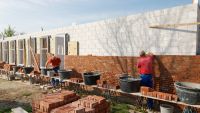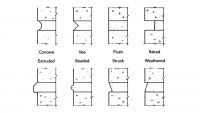Anchoring stone veneer
Connectors, anchors and fasteners
By Paul Curtis
Excavations throughout Europe have found stone used for shelter as far back as 12,000 B.C. Cast stone was used in France as far back as 1158 A.D. Today, stone remains one of the strongest and most durable building products on the planet. When using stone as a veneer, engineering and design are critical factors in a successful building project.
Anchored veneer and adhered veneer
TMS402/ACI530/ASCE6 Building Code Requirements and Specification for Masonry Structures list several references and guidelines for adhered veneer. Anchored dimensional stone is not covered currently under the code and is considered a “special system.”Adhered veneer
The code defines adhered veneer as a “masonry veneer secured to and supported by the backing through adhesion.” No rational design provisions exist for adhered veneer in any code or standard. The following alternative design of adhered masonry veneer permitted under Section 1.3 of the TMS402 code requires the following conditions:- Loads must be distributed through the veneer to the backup using principles of mechanics
- Out-of-plane curvature shall be limited to prevent veneer unit separation from the backup
- Masonry, other than veneer, must meet all the provisions of the code
- The veneer is not subject to the flexural tensile stress provisions or the nominal flexural tensile strength provisions of unreinforced masonry.
- Units cannot exceed a thickness of 2 5/8 inches (66.7 mm), 36 inches in any face dimension or more than five square feet in face area, and cannot weigh more than 15 psf
- The height, length and area of adhered veneer is not limited, except as required to control restrained differential movement stresses between the backup wall and the veneer; some states have a 30-foot height limit for adhered veneer
- The backup wall can be masonry, concrete or metal lath, and Portland cement plaster applied to masonry, concrete, steel framing or wood framing
- Adhesion between the veneer units and the backup must have a shear strength of at least 50 psi, based on gross unit surface area when tested in accordance with ASTM C482 or shall be added in compliance with the following:
- Brush a paste of neat Portland cement on the backup wall and the back of the veneer unit
- Apply Type S mortar to the backup and the veneer unit
- Tap veneer unit into place, completely filling the space between the unit and the backup, and use enough mortar to create a slight excess to be forced out between the edges of the veneer units; the mortar thickness between the backup and the veneer should be greater than 3/8 inch and less than 1 ¼ inch.
- Tool the mortar joint with a round jointer when the mortar is thumbprint hard.
Wood or steel frame backup walls with adhered veneer must be backed with a solid, water-repellent sheathing. Note that care must be taken when adhered masonry veneer is used on steel frame or wood frame backing to limit deflection of the backing, which can cause veneer cracking or loss of adhesion. The surface of the backing material must be capable of securing and supporting the imposed loads of the veneer. Materials that may affect bond such as dirt, grease, oil or paint (except Portland cement paint) should be cleaned off the backing surface prior to adhering the veneer.

Anchored stone veneer
Stone veneer units are limited to a maximum thickness of 10 inches. Anchored stone veneers must be designed by a licensed engineer through a three-step process:- Analyze the stone: Find the stress point of the stone. Use a safety factor of 5-1. Start with two anchors on top and two on the bottom at quarter points. The goal is to support the stone without cracking. Add more anchoring points if necessary.
- Evaluate the backup wall.
- Design the stone anchors to transfer the loads from the veneer to the backup. The distance from the backup wall to the center of the stone is fixed. Loads can be increased by making the anchor thicker and/or wider. Use a safety factor of 4-1 for the anchors. Finally, analyze the fasteners for the attachment of the anchor to the backup.
A contractor, when bidding on an anchored stone veneer project, should assure the engineering is factored into the bid. The engineering responsibility varies from job to job. Sometimes it is the responsibility of the mason contractor, general contractor or the stone provider. A few times a year, we get a call whereby stone already is on the jobsite, and the contractor is looking for “off the shelf” stone anchors (which don’t exist). A mad scramble ensues, during which the mason contractor, general contractor, engineer and stone provider bicker about who will pay for the engineering, since nobody put it into the bid. During this time, the job usually gets put on hold.
The four most common types of stone anchors are shown below. The pin type usually is installed with the pin loose, so the anchor can be attached to the backup and the hole used as a template to drill down into the stone. The top stone is brought into place, and a hole is drilled up. The three anchors with bends are used at the top (Z-Type), bottom (U-Type) and between two stones (Split-bend Type). The engineering process will determine the width and thickness of these anchors.

- Backup wall must be designed to resist water penetration and be covered with a continuous water-resistant membrane, unless the sheathing already is water resistant and the joints are sealed
- Flashing and weep holes in exterior veneer must be designed and detailed to resist water penetration into the building interior
- Design and detail the veneer to accommodate differential movement.
Originally published in Masonry magazine.
About the Author
Paul Curtis is president and third-generation owner of Heckmann Building Products, Inc. Heckmann has been manufacturing masonry anchors and ties since 1923.




















